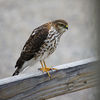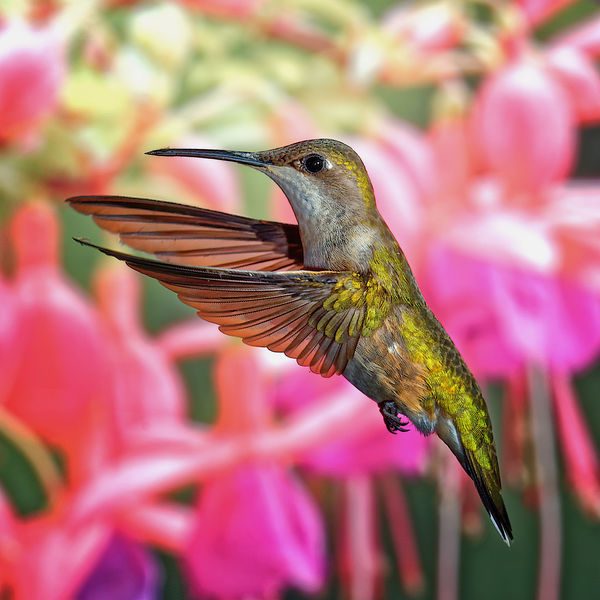ISO 50
Mar 31, 2016 08:57:28 #
imagemeister wrote:
Shooting at ISO 50 makes possible the absolute best imaging performance from the sensor - just as Kodachrome 25 did in the film world ! It also enables slower shutter speeds - if that matters.
RIP Kodachrome 25 and 64. What great colors!
Mar 31, 2016 10:02:17 #
sendero72
Loc: Candler, North Carolina
My friend as been a professional architectural photographer for the last 35 years. He shoots 4x5 and at the same time shoots a full frame Canon with shift tilt lens. He shoots ISO 50 most of the time and his prints from the 35mm, up to 4x6 feet, look stunning at their proper viewing distance. We shot waterfalls last fall using 35mm only and he shot at ISO of 50 while my Nikon D7100 will only go to 100 ISO at f-stops of 16-32. He just purchased to new Canon 50 Megapixel body on Monday. I think the key is the correct steps from raw image to the final print.
Mar 31, 2016 10:52:50 #
sendero72 wrote:
My friend as been a professional architectural pho... (show quote)
Digital ISO, not film. Film is another beast, especially when using a view camera.
Mar 31, 2016 12:29:04 #
Several days ago, Jerry posted this link about ISO. It explains 50 ISO.
Runtime about twenty two minutes.
http://www.uglyhedgehog.com/t-378606-1.html
Runtime about twenty two minutes.
http://www.uglyhedgehog.com/t-378606-1.html
Mar 31, 2016 12:50:20 #
I shoot ISO 50 on my Kodak P880 because it has a CCD that absolutely sucks at ISO 400. My two favorite bridge cameras, the Z812 and Z8612, both have ISO 64. This is one of the few areas where micro four thirds falls short, with the Kodak and Olympus only going to ISO 200 and the Panasonic having a "fake" ISO 125.
Mar 31, 2016 13:15:23 #
f/1.1 is the extreme for Nikon. I don't have one, though. ;>(
SharpShooter wrote:
Yes, this would be correct. br I beilieve there a... (show quote)
Mar 31, 2016 13:24:26 #
RWR wrote:
The first exposures I made with my Nikon Df was an exposure latitude test, and the only difference I could see from ISO 100 was a little increase in contrast. This is noted in the manual, which also says to use ISO 50 for larger apertures when lighting is bright.
In line with RWR's quote of the Nikon remark for his Df, I searched for quite some time to see if ISO 64 (native on D810) is preferred to ISO 100 for the D810, all else equal. Somewhere, Nikon said to prefer ISO 64.
Was pleasantly surprised that my digital light meter recognizes ISO 64, but then, I'm fairly new at this discipline.
Mar 31, 2016 13:28:23 #
amfoto1
Loc: San Jose, Calif. USA
davidrb wrote:
I'm wondering what that application for an ISO this low. Does anyone here use this and under what circumstances do you use it? Google search gave little information. DPReview had a minor discussion but nobody I can find uses it. It's on cameras for a reason, what might that be?
Many modern digitals don't have ISO 50... but a few do. In all I'm aware of it's a software interpolated "pull" down from the native ISO (usually 100... 200 in a few cases), which might cause a slight loss of contrast or dynamic range (where "push" ISOs above the native tend to have increased image noise and some loss of resolution... both increasing with each higher step up in ISO).
Actually, I wish they were able to provide even lower ISO such as 25, 12 and even 6. There are times they would be useful... but probably not practical as yet.
An extra low ISO (i.e., decreased sensor sensitivity to light) can be useful when you want to use a slow shutter speed for blur effects. It also can be helpful when wanting to use an extra large aperture for shallow depth of field effects in brighter lit conditions.
With DSLRs mostly offering no slower than 100, and only some 50 ISO, today we instead use quality Neutral Density filters for the same reasons.
Back in the days of film really slow, low ISO also tended to be the most grain free.... "Slow" film had the finest silver halide structure. For that reason I used a lot of Kodak 25 and 32 B&W films... until Fuji came out with their Neopan Acros 100 which had equally fine grain, but with a richer pallet.
There also were a lot of ISO (actually ASA in those days) 25, 32 and 64 color films... both negative for prints and slide transparency in the 1950s.... The slow negative films gradually disappeared in the 1960s, but some of the slow slide films were still being offered into the 1970s and later. In fact, Fujichrome Velvia 50 (which I always liked better than most faster slide films) is still available in 35mm, 120, 4x5 and 8x10 formats.
This is not the case with digital. ISO's below the native give up some image quality, instead of improving it. So, depending upon what you're trying to do, it might be better to avoid any extra low ISOs.
Mar 31, 2016 13:42:47 #
Leitz
Loc: Solms
amfoto1 wrote:
Many modern digitals don't have ISO 50... but a few do. In all I'm aware of it's a software interpolated "pull" down from the native ISO (usually 100... 200 in a few cases), which might cause a slight loss of contrast ...
With the Nikon Df, as RWR wrote and the user's manual states, ISO 50 results in an increase in contrast, not a decrease.
Mar 31, 2016 14:11:21 #
Mar 31, 2016 14:24:51 #
imagemeister wrote:
Shooting at ISO 50 makes possible the absolute best imaging performance from the sensor - just as Kodachrome 25 did in the film world ! It also enables slower shutter speeds - if that matters.
It certain facilitates slow shutter speeds but not necessarily better sensor performance. It depends on the sensor and how the lower ISO is achieved.
Mar 31, 2016 15:11:46 #
davidrb wrote:
I'm wondering what that application for an ISO this low. Does anyone here use this and under what circumstances do you use it? Google search gave little information. DPReview had a minor discussion but nobody I can find uses it. It's on cameras for a reason, what might that be?
I could use it. To take photos that are totally under my control in daylight, I use powerful flashes do overpower the sunlight for the brief period that the strobe light(s) are on. This negates the effect of ambient lighting and lets me stop the action of the bird. See the attached example where the ISO was reduced to 100.
Mar 31, 2016 15:41:14 #
Blurryeyed wrote:
I have a Canon 6D, fastest shutter speed on that camera is 1/4000th, on bright days shooting at wide apertures for shots that need shallow DOF the camera will want shutter speeds faster than 1/4000 when shooting at ISO 100. It is my understanding that ISO 50 is a software simulation, that you are not actually shooting at ISO 50.
My K5 starts at iso 80 and gets the maximum dynamic range at that iso.
This was measured by DX0. I think it is established that as you raise iso you lose dynamic range.
Mar 31, 2016 16:12:20 #
blackest wrote:
.../... I think it is established that as you raise iso you lose dynamic range.
You are absolutely right. But it also drops when you use the lower ranges. Each camera sensor type has optimal settings, finding them is key to exploit a camera DR then finding the lenses optimal settings allows for even greater results...
Draw back is that you never really get the best of both as there is a give and take, the usual conundrum:
What is more important?
Mar 31, 2016 16:26:44 #
Davethehiker wrote:
I could use it. To take photos that are totally under my control in daylight, I use powerful flashes do overpower the sunlight for the brief period that the strobe light(s) are on. This negates the effect of ambient lighting and lets me stop the action of the bird. See the attached example where the ISO was reduced to 100.
That is an incredibly great photograph of a hummingbird in mid-flight. I'm not sure why you want to negate ambient lighting but you have "stopped" the bird in flight. The wings are in normal flight and the bird is relaxed. Those two features are semi-unusual to see together, feeding. The feathers are fairly even. The only thing missing would be the bird's tongue sticking out. Nice work.
If you want to reply, then register here. Registration is free and your account is created instantly, so you can post right away.










